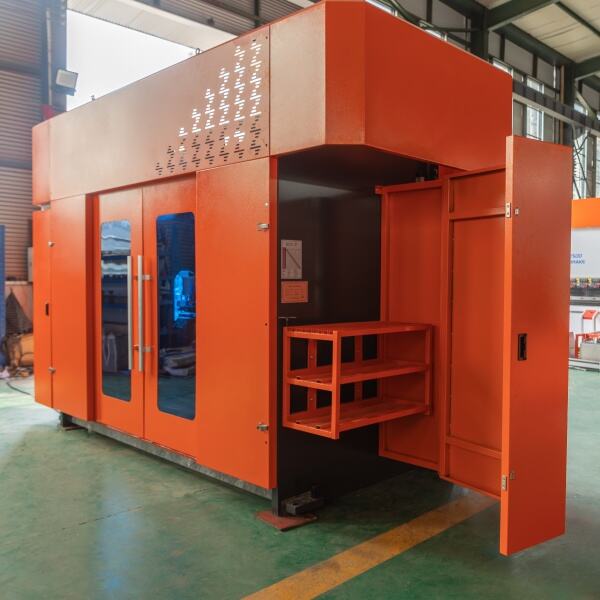Hydraulic Press Brake Machine Advantages in Industrial Metalworking
Superior Power Output for Thick-Gauge Materials
Hydraulic press brakes pack serious power, which makes them great for working with thick metal sheets like steel and aluminum alloys. When these machines bend metal, they produce really strong results that industries need for all sorts of manufacturing jobs. Because they can push so much force during bending, shops actually save time on each job and get more parts made throughout the day. Some heavy duty models with twin cylinder systems can crank out around 3000 tons of pressure, giving factories a major boost in what they can accomplish. This kind of muscle lets fabrication shops tackle those tough bending orders without breaking a sweat, which means better productivity across the board for anyone running an industrial operation.
Durability in High-Volume Production Environments
Hydraulic press brakes really shine when it comes to lasting through heavy production work. Built with tough steel frames and hardened components, these machines hold up against constant use day after day, week after week. Unlike some alternatives on the market, they don't break down as often because there aren't so many little parts wearing out over time, which means less time spent fixing them and more time actually making products. Some shops report getting two decades or more from their hydraulic systems if properly maintained, something that's become pretty common in metal fabrication shops across North America where uptime matters most.
Flexibility Across Multiple Metalworking Applications
Hydraulic press brakes are pretty flexible machines that work well with all sorts of materials from thin sheet metal to thicker plates. They find their way into lots of industries too, think car manufacturing, airplane parts production, and regular metalworking shops. When operators need to switch between steel, aluminum or different gauge metals, they just tweak a few controls and get back to work quickly rather than waiting around for lengthy setup changes. For factory owners, this kind of machine adaptability makes a big difference. It means they can pivot fast when orders come in for something unexpected, which keeps customers happy and helps maintain a solid position against competitors in today's ever-changing market landscape.
Precision Engineering with CNC Hydraulic Press Brakes
Automated Bending Accuracy via CNC Programming
CNC hydraulic press brakes come with advanced software that really boosts accuracy during bending operations while cutting down on mistakes made by humans. The automated programming features let manufacturers hit those super tight tolerances we all know and love, sometimes getting down to around plus or minus 0.01 millimeters. When making components that need to be spot on, this kind of precision matters a lot. Companies that spend money on these CNC machines tend to see their precision numbers go way up too. Some research shows improvements hovering around 50% in certain cases. Bottom line? Parts coming off these machines consistently hit those tough quality standards that customers demand nowadays in the fast paced manufacturing world.
Real-Time Angle Correction Technology
Today's CNC hydraulic press brakes come equipped with real time feedback systems that automatically adjust the bending angle when working with different materials. These systems help cut down on waste and keep finished parts matching exactly what was specified in the blueprint, which matters a lot for quality control in manufacturing shops. Some research indicates that factories using these kinds of correction features see about a 30 percent drop in rework expenses. The improvements we've seen in CNC tech really highlight why it makes sense to invest in these machines for any operation where getting measurements right is absolutely essential.
Consistent Results in Batch Processing Scenarios
Bringing CNC tech into hydraulic press brakes makes all the difference when it comes to keeping things consistent between different production batches. These computer controlled systems can replicate those exact same bends again and again, even when cranking out thousands of parts at once. That means what goes out the door looks pretty much identical every time. Most shops have started incorporating some sort of statistical quality checks right into their CNC setups now too. Some reports claim these systems hit around 95% consistency rates or better. For metal fabricators trying to maintain product standards while scaling up operations, this kind of repeatability saves headaches down the line. The shop floor guys know this well after seeing how many defects disappear when switching from manual to CNC bending processes.
Enhanced Safety Features for Operator Protection
Advanced Light Curtain Safety Systems
Light curtain safety systems now play a vital role in modern hydraulic press brake operations. These devices create invisible barriers around dangerous areas, automatically stopping the machine whenever someone's hand gets too close to moving parts. Workers no longer need to rely solely on physical guards or manual controls, which cuts down on serious injuries during production runs. Most manufacturers build these systems according to ISO 13849 and other global safety regulations, so businesses know they're meeting legal requirements while protecting their staff. Industry data shows factories that install light curtains typically see accident rates drop somewhere between 35% and 45% within the first year alone. Beyond just preventing harm, these systems help maintain consistent productivity since downtime from injuries drops substantially as well.
Dual-Hand Operation Requirements
Most hydraulic press brakes come with what's called dual hand operation requirements. Basically, this means workers need to use both hands to start the machine running. The whole point of this setup is to keep those hands away from dangerous spots near the machine, which helps everyone stay safer while working around these big pieces of equipment. When someone has to put both hands on controls at once, there's just less chance they'll accidentally hit something wrong. Factory floor data shows pretty clearly that machines with these dual control systems tend to cause way fewer injuries among workers. That's why so many shops across different industries now see this as standard practice rather than optional extra safety gear.
Emergency Stop Functionalities
The emergency stop buttons found on hydraulic press brakes need to be within easy reach so workers can shut things down fast when something goes wrong. Getting to these stops matters a lot for workplace safety, and they work best when companies stick to proper safety rules like checking them regularly and making needed updates. When emergencies happen, having good emergency systems makes all the difference. Some industry reports show that stopping an incident right away can cut serious injuries down by around 70 percent. Factories that invest in quality emergency systems not only protect their staff better but also tend to run smoother day to day since everyone feels more secure knowing help is just a button press away.
Cost-Efficiency in Large-Scale Operations
Reduced CNC Press Brake Price Per Unit Output
While buying CNC hydraulic press brakes might look expensive at first glance, they actually save money in the long run. The machines cut down on what it costs to make each item, which becomes really valuable when companies grow bigger. Some factories report their costs per part dropping around 25% because these presses work faster and create less scrap material. Makes sense for big manufacturing operations too since keeping things running smoothly means the difference between good profits and thin ones. Companies that invest in these advanced pressing systems often find themselves with healthier bottom lines after just a few months of operation.
Energy Consumption Comparison: Hydraulic vs Electric Models
When looking at how much energy they actually consume, hydraulic press brakes tend to beat out electric versions when dealing with really tough jobs. The difference isn't just theoretical either many shops report real money saved on their utility bills after switching over. These hydraulic machines just run better for what they do, saving around 30% on power during those repetitive pressing cycles that factories live on. And there's another bonus nobody talks about enough these days: running hydraulic equipment means putting less strain on the environment overall. Factories that switch to hydraulics typically see their carbon emissions drop significantly, which helps them meet those green targets while still getting the job done right. Most manufacturers find this dual benefit of lower costs and cleaner operation makes all the difference in staying competitive today.
Long-Term Maintenance Cost Advantages
Hydraulic press brakes tend to last longer and work more reliably than many alternatives, which means they cut down on maintenance expenses over the years. When compared against pneumatic or mechanical systems, these hydraulic setups just need fewer fixes and those repairs typically cost less when they do happen. Shop floor experience shows that with proper care routines and good quality parts, some facilities report spending around 5% annually on maintenance at most. For manufacturers looking to save money while keeping production running smoothly, this makes a strong case for going with hydraulic systems. Most plant managers we talk to have made the switch because the bottom line benefits stack up pretty nicely over time.
IoT Connectivity in Modern Hydraulic CNC Press Brakes
Real-Time Performance Monitoring Systems
Manufacturers are increasingly connecting their hydraulic CNC press brakes to IoT systems that let them track performance as it happens, making operations run smoother overall. These connected systems give ongoing visibility into how machines are actually being used day to day, so technicians can spot issues early and keep everything running at peak levels. Take predictive maintenance for example the data these systems gather often flags when parts might fail weeks before they actually break down, cutting unplanned stoppages by around 40% according to recent studies. Beyond just watching equipment status, forward thinking firms are diving deeper into IoT analytics to tweak production timelines and fine tune machine parameters, effectively rewriting what was once considered standard practice in factory environments across North America and Europe.
Predictive Maintenance Through Data Analytics
Data driven predictive maintenance is changing the game for manufacturers when it comes to keeping their equipment running smoothly. When companies look at real world usage patterns and how fast machines actually wear down, they start creating maintenance plans that keep hydraulic CNC press brakes going longer between repairs. Getting predictive maintenance right means fewer surprise breakdowns, which saves money in the long run. Some studies show factories implementing these systems see around half the downtime compared to traditional methods. For production shops trying to stay competitive, this kind of reliability makes all the difference in meeting deadlines and avoiding costly production halts.
Integration with Smart Factory Networks
Hydraulic CNC press brakes are now playing key roles in smart factory setups, where they connect easily with other machines on the shop floor for smooth information sharing across the manufacturing process. When connected properly, factories become much more flexible operations that adjust quickly when orders change or new requirements come up. Many shops that have adopted these smart systems see real improvements in how fast things get done and how efficiently resources are used throughout their facilities. For metal fabrication businesses especially, getting hydraulic CNC press brakes online with factory networks means they can handle complex jobs without missing deadlines, something that keeps them ahead of competitors who still rely on older methods of operation.
Table of Contents
- Hydraulic Press Brake Machine Advantages in Industrial Metalworking
- Superior Power Output for Thick-Gauge Materials
- Durability in High-Volume Production Environments
- Flexibility Across Multiple Metalworking Applications
- Precision Engineering with CNC Hydraulic Press Brakes
- Automated Bending Accuracy via CNC Programming
- Real-Time Angle Correction Technology
- Consistent Results in Batch Processing Scenarios
- Enhanced Safety Features for Operator Protection
- Advanced Light Curtain Safety Systems
- Dual-Hand Operation Requirements
- Emergency Stop Functionalities
- Cost-Efficiency in Large-Scale Operations
- Reduced CNC Press Brake Price Per Unit Output
- Energy Consumption Comparison: Hydraulic vs Electric Models
- Long-Term Maintenance Cost Advantages
- IoT Connectivity in Modern Hydraulic CNC Press Brakes
- Real-Time Performance Monitoring Systems
- Predictive Maintenance Through Data Analytics
- Integration with Smart Factory Networks



